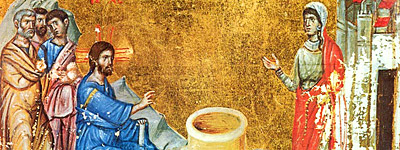

| Previous day | Next day |
| Old Style
May 5
|
Sunday |
New Style
May 18
|
| 5th Sunday of Pascha. Sunday of the Samaritan Woman. Tone 4. | No fast.
|
![]() Great-martyr Irene of Thessalonica (1st c.-2nd c.).
Great-martyr Irene of Thessalonica (1st c.-2nd c.).
St. Barlaam of Serpukhov (1377). Uncovering of the relics of St. James, founder of Zhelezny Borok Monastery (Kostroma) (1422) New Monk-martyr Ephraim of Nea Makri (1426). St. Adrian, founder of Monza Monastery (Galich) (1610).
Icon of the Most Holy Theotokos 'Inexhaustible Cup' (1878).
Sts. Martin and Heraclius, of Illyria (4th c.). St. Eulogius the Confessor, bishop of Edessa (ca. 386). St. Hilary, bishop of Arles (449). St. Euthymius the Wonderworker, bishop of Madytos on the Hellespont (ca. 990).
Thoughts for Each Day of the Year
According to the Daily Church Readings from the Word of God
By St. Theophan the Recluse

Sunday of the Samaritan Woman. [Acts 11:19–26, 29–30; John 4:5–42]
The Samaritan’s woman fellow citizens said to her after two days with the Saviour in their midst, Now we believe not because of thy saying: for we have heard him ourselves, and know that this is indeed the Christ, the Saviour of the world (John 4:42). It happens this way with everyone. At first they are called to the Lord by an external word, or as for many now, simply by birth. But when they taste in practice what it is to live in the Lord, they no longer cleave to the Lord through their external affiliation with Christian society, but through their inner union with Him. It is necessary for all who are born in Christian societies to make this a law for themselves; that is, to not limit themselves to mere external affiliation with the Lord, but to seek to unite with Him inwardly, that they may always bear witness within themselves that they are standing in the truth. Why is this necessary? It is necessary to embody within oneself the truth of Christ. The truth of Christ is a restoration of what is fallen. Thus, put off the old man, which is corrupt according to deceitful lusts, and put on the new man, which is created after God in righteousness and true holiness (cf. Eph. 4:22–24), and you will know within yourself that the Lord Jesus Christ is in truth the Saviour—not only for the world, but also for you.
Articles
 Venerable James the Abbot of ZheleznoborovAs a youth he went to Saint Sergius of Radonezh, received monastic tonsure from him, and lived at the Trinity monastery for several years. |
 Sunday of the Samaritan Woman |





